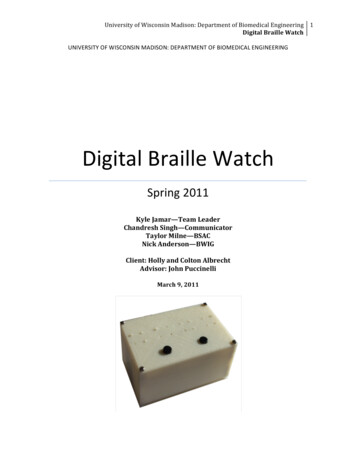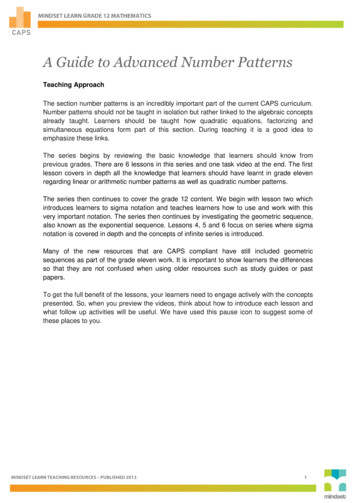
Transcription
University of Wisconsin Madison: Department of Biomedical EngineeringDigital Braille WatchUNIVERSITY OF WISCONSIN MADISON: DEPARTMENT OF BIOMEDICAL ENGINEERINGDigital Braille WatchSpring 2011Kyle Jamar—Team LeaderChandresh Singh—CommunicatorTaylor Milne—BSACNick Anderson—BWIGClient: Holly and Colton AlbrechtAdvisor: John PuccinelliMarch 9, 20111
University of Wisconsin Madison: Department of Biomedical EngineeringDigital Braille Watch2Table of ContentsABSTRACT . 3BACKGROUND . 3PROBLEM STATEMENT. 3BRAILLE BASICS . 4CURRENT METHODS . 5PAST DESIGNS. 7DESIGN CRITERIA AND CONSIDERATIONS . 9DESIGN SPECIFICATIONS. 9FUNDING . 10DISK AND PINS . 10ODOMETER CONCEPT . 12GEAR ANDPINS . 13DESIGN EVALUATION .15FUTURE WORK . 16REFERENCES. 19APPENDIX A: PRODUCT DESIGN SPECIFICATIONS . 20
University of Wisconsin Madison: Department of Biomedical EngineeringDigital Braille WatchAbstractThe Braille language has provided the visually impaired with a way to readand write for many years, yet no device exists that allows the visually impaired toread the time in Braille. In order to tell time, the visually impaired currently rely oneither talking or tactile watches. However, talking watches are disruptive, whiletactile watches are difficult to read and fragile. Our goal is to design a watch thatallows the visually impaired to read the time in standard Braille. In order toaccomplish this, three preliminary Braille watch design options were proposed. Thefirst idea is to improve upon the prototype developed by the Fall 2010 Braille watchdesign team. This prototype involved four disks which each rotated beneath a set offour pins. Incorporating a gear mechanism could minimize the power consumptionof this design, but in its current form this would be challenging to accomplish. Thesecond option utilizes technology found in a standard odometer. It would consist offour disks with raised and lowered surfaces cut into the rim of the disk. A set of fourpins would rest above each of these disks and would be raised or lowereddepending upon where they rested. A gear mechanism similar to that found in astandard odometer would be used to rotate each disk. The final design option is ahybrid of design options one and two. This design utilizes four disks which eachrotate beneath a set of four pins. The surface of each disk is divided into three rings:outer, middle, and interior, in which raised or lowered surfaces are cut. As the disksrotate by way of a gear mechanism, the pins are raised and lowered to display thedesired numbers. Due to the minimal size and low power consumption presentedby this design, it was chosen as the design option to pursue. Future work includesfinalizing the design, assembling a prototype, testing, and performing finalmodifications to the prototype based on the testing results and client’s input.BackgroundProblem StatementIn order to determine the time, the visually impaired currently depend ontalking or tactile analog watches. However, talking watches are disruptive, while the3
University of Wisconsin Madison: Department of Biomedical EngineeringDigital Braille Watchtactile analog watches are difficult to read and fragile. Our client desires a devicethat uses the standard Braille number system to display the time. This deviceshould be no larger than a standard Smartphone, have a self‐contained powersupply, and use standard Braille spacing.Braille BasicsThe Braille language is the universally accepted form of writtencommunication for the visually impaired. It utilizes a system of dots arrayed in athree row by two column grid. Raised dots are then located in any of the sixpositions, displaying different letters, numbers, and symbols based on theirconfiguration.In order for this method of communication to be accurate and precise,universal specifications have been developed. Each dot must have a base diameterof 1.44 millimeters (0.057 in.) while being 0.48 millimeters (0.019 in.) in height.Within each individual grid, the dots must be at least 2.34 millimeters (0.092 in.)apart, measured center‐to‐center, and each individual character should be aminimum of 6.22 millimeters (0.245 in.) away from the neighboring character. [1]Figure 1 – Braille numerals 0 9Image courtesy of le‐alphabet.htmlTo simplify matters for this design, the numbers 0‐9 are represented usingonly the top four dots of the three by two grid (Figure 1). Instead of having tomanage an oblong, rectangular three by two grid, the design of the watch is muchsimpler and requires only a two by two grid to display any number.The distance between two Braille pins must be at least 2.34 millimetersapart, since this is the minimal distance required to distinguish between two pointswith the fingertip. This minimal distance is determined by mechanoreceptorslocated on the skin, which are activated by the slightest deformation of the skin due4
University of Wisconsin Madison: Department of Biomedical EngineeringDigital Braille Watchto contact. In order to discriminate between two points, there must be a deactivatedreceptor located between two activated receptors. Without the presence of adeactivated receptor, the brain would perceive the contact of the two points as onestimulus.These receptors are distributed all over the body; however, they exist insome areas in higher concentration. The distribution of these touch receptors isrepresented by a homunculus diagram, which shows that these receptors arepresent in high concentration in the fingertips, making them more sensitive totouch. It was important to consider these sensory limitations when designing thewatch. [2]Current MethodsThere are two main categories of watch products currently on the market forthe visually impaired: talking watches and analog tactile watches. Talking watchesfunction by verbally relaying the time to the user whenever the user presses abutton (Figure 2). This method is effective inFigure 2 – Talking watchesverbally communicate thetimeImage courtesy of IndependentLiving Aids, number 756480communicating the time; however, it can be disruptive and draws attention to theuser. Analog tactile watches, on the other hand, are silent (Figure 3). They function5
University of Wisconsin Madison: Department of Biomedical EngineeringDigital Braille WatchFigure 3 – Visuallyimpaired touch the handsof the tactile analog watchto tell the timeImage courtesy of hes‐by‐auguste‐reyondmuch like traditional analog watches, except in this case in order to tell the time theuser must touch the face of the watch to feel where the hands are located. There arealso raised markings on the watch that indicate the positions of the numbers;however, there is no standard format for these markings and they vary fromproduct to product. Our client has informed us that these watches can be difficult toread and come with a learning curve when first used. Also, the hands of thesewatches are exposed while the user is telling the time, and therefore they can beeasily broken or damaged.In addition to these currently available watch products, there is a watch thathas recently been designed called the Haptica Braille Watch (Figure 4). This designfeatures a set of 16 rotating disks that circulate Braille dots in and out of the displayto assemble the desired Braille numerals. Each disk contains a single Braille dot thatis moved in concert with the other disks to display the time in Braille. This conceptwas created by David Chavez in 2008. Chavez is not an engineer and has not createda prototype for his design. [3]6
University of Wisconsin Madison: Department of Biomedical EngineeringDigital Braille WatchFigure 4 – Haptica BrailleWatch design by DavidChavezImage courtesy of Tuvie Designof the tch‐concept/Past DesignsThis is the fifth semester that a team has worked on this project. The first twoteams developed a vibrating dots design. It features four vibrating motors thatvibrate in sequence to communicate the time (Figure 5). When the user presses aFigure 5 – Vibrating dots prototypecreated by past BME design teamImage courtesy of BME 200 Fall 2008Design Teambutton on the watch, the four motors vibrate to signify one Braille numeral, and,after a short pause, they vibrate again to denote the second numeral. This process isrepeated until all four numerals have been relayed to the user.7
University of Wisconsin Madison: Department of Biomedical EngineeringDigital Braille WatchThe fall of 2008 team that worked on this project was able to construct aworking prototype of this design; however, it had some major drawbacks. Aftertesting the device, Colton informed the team that many visually impaired peoplehave increased sensitivity to touch in their hands. This is due to the fact that manyuse their fingers to detect subtle tactile differences, including those encounteredwhile reading Braille. As a result, the vibrations of this prototype had an over‐stimulating effect. Also, because of the size of the watch, the user must use theirentire hand to read the device. This ends up creating an experience that is verydifferent from actual Braille reading, which only requires one fingertip. In addition,the design had high power consumption.The design shown in Figure 6 was designed by last spring’s design team.Figure 6 Internal view of rotating diskprototypeImage Courtesy of Spring 2010 BrailleWatch TeamTheir design uses eight rotating disks to form the required Braille numerals. Eachdisk has four raised dots, which can be configured to form the top or bottom half ofthe character cell (Figure 7). [4]This design met the client’s requirements and was the first existing Brailletime‐keeping device. However, many downfalls exist with this design. As can beseen in Figure 7, the prototype is too large to fit on the wrist of a user, thus, the sizemust be cut down significantly. Also, this device uses eight moving parts, leading tohigh power consumption. With this design, there was not much opportunity to8
University of Wisconsin Madison: Department of Biomedical EngineeringDigital Braille Watchsignificantly cut size and power use. Finally, due to the mechanical nature of thisdesign, the Braille numbers were often difficult to read. The Braille display reliedheavily on the accuracy of the servo motors used to rotate the disks.Figure 7 – By a rotation of 90º, 180º or270º, the disks can display the correct timeImage Courtesy of Spring 2010 Braille WatchTeamDesign Criteria and ConsiderationsDesign SpecificationsThe clients for this project are Holly and her visually impaired son ColtonAlbrecht. Together, they came up with the idea for the Digital Braille Watch. As such,the project will be created in accordance to their wishes and specifications. Theirmain requirements are that the design is able to correctly display the current timein standard Braille and operate without any noise. The watch must not bedangerous to the user, so moving parts and electronic components must becontained properly. It has to be accurate within the minute whenever it is connectedto a power source. Holly and Colton did not request that the prototype is anyparticular size; rather, they are looking for a proof of concept. However, theprototype should be designed so that it would be possible to scale down to watch‐size in the future. For more information on the product design specifications, seeAppendix A.9
University of Wisconsin Madison: Department of Biomedical EngineeringDigital Braille WatchFundingSince caring for a visually impaired child can be financially taxing, it isdifficult for our client to provide funding for this project. As a result, we turned tooutside sources to try to offset the financial burden on our client. Based on advicefrom our advisor, John Puccinelli, we will be consulting with the University ofWisconsin Madison Department of Biomedical Engineering (BME) to fund ourproject. A budget proposal is not needed for this project since expenses should notexceed 50.Disk and PinsThe first design option was that which was developed by this teamlast semster: the disk and pins design (Figure 8). The basis of this design was fourdisks located beneath the watch surface, one for each Braille numeral. Above eachFigure 8: Disk and pins prototypedeveloped by last semester’s teamdisk four pins were positioned so that they rest on the disks’ surface. The portion ofthe disk against which the pins rest has both raised and recessed sections (Figure 9).If a pin is on the raised surface, it will be pushed slightly above the watch plane, andif not, the top of the pin will remain flush with the surface of the watch (Figure 10).When the disk rotates to different positions different combinations of pins areraised. In this way all necessary numbers can be displayed.10
University of Wisconsin Madison: Department of Biomedical EngineeringDigital Braille WatchFigure 9– The raised and recessedsurfaces on the disk cause differentnumbers to be displayedFigure 10: The raised surface onthe disk pushes the Braille pin tothe surface of the watchA benefit to this design over that of the previous team is that only fourmoving parts are needed. This cut down on the energy necessary to run the watch.Also smaller servos were used since only 165 of rotation was needed to rotate thedisks opposed to the 270 previously needed. This design also removed theambiguity of the Braille number display. The pins remained in place, causing theBraille dots to remain aligned. However, upon completion of a prototype, several11
University of Wisconsin Madison: Department of Biomedical EngineeringDigital Braille Watchshortfalls of this design were apparent. The design still consumed too much energy,as a USB cord was needed to power the watch. In addition, the spacing of the Braillecharacters and dots within the Braille characters was much larger than standard.These two major concerns made it difficult to work with this design in its currentform. A design that could optimize power consumption and spacing of thecharacters would be preferred.Odometer ConceptInspired by the previous design concept, this design entails setting up asystem of gears in a way that only one gear needs to be rotated in order to controlthe entire watch. A gear system of this exact type is shown in the design of anodometer in Figure 11. Looking at the white gear in the figure, it can be seen thatthere are only two pegs on its left side. This is the key to the proper function of anFigure 11 – The odometer gearsystem requires the rotation ofone gear to control the displayImage courtesy of meter1.htmodometer. Due to this design, the white gear only briefly comes in contact with theintermediate opaque gear for every rotation. This contact is enough to rotate thefirst black gear from one number to the next. Each gear is connected to its adjacentgear in this way. [5] By using this gear system combined with the raised and lowereddisk surface idea introduced previously, a functional Braille watch could be created.12
University of Wisconsin Madison: Department of Biomedical EngineeringDigital Braille WatchFigure 12 shows how raised and lowered surfaces along the circumference of eachdisk could be used to display each number.Figure 12: The raised and loweredsurfaces along the cirucumference ofthe disks could be designed to raiseand lower pins in the configuration ofany Braille numberThis design could easily achieve standard Braille spacing. In addition, due tothe gear system, a constant angular velocity would need to be applied to only onedisk in order to operate the entire watch. This would lead to a significant decreasein power consumption and also allow for the elimination of any servo motors ormicrocontrollers, further optimizing space. The largest downfall to this designregards the final dimensions of a prototype. The height of the final design would bebased on the diameter of the disks, since each is standing on its side to raise andlower the pins. Some preliminary calculations suggested that this height may be aslarge as one inch, a thickness too large for a watch. A compact design that functionssimilar to this one would be ideal.Gear and PinsThe Gear and Pins design utilizes the raised and lowered surfaces introducedwith the Disk and Pins design. There are once again four disks, one for each Brailledigit displayed, which have raised and lowered portions (Figure 13). Four pins setwith standard Braille spacing rest on a section of the disk aligned over threeseparated tracks, with the two diagonal pins functioning off of the same track(Figure 14). As the disk rotates, combinations of raised and recessed sectionsbeneath the pins change, subsequently altering the number being displayed.13
University of Wisconsin Madison: Department of Biomedical EngineeringDigital Braille WatchFigure 13: A disk with different combinationsof raised and lowered segments can display adesired range of numbersFigure 14: Number layout of a Gear andPins disk, which can display the numbers0 9 as it completes its rotationAnother important aspect of this design is the gear system that existsbetween the disks. This system allows for the full rotation of one disk to betranslated into a partial rotation of the following disk. Each disk has teeth around itsedge, with number and length varying from disk to disk. As can be seen in Figure 15,a full rotation of the one tooth gear will lead to a partial rotation of the multi‐toothgear. The number of degrees the disk is turned is determined by the peg length andnumber of pegs present on the disk. This gear mechanism allows for the continuousmotion described in the odometer concept design to be utilized. The disks are14
University of Wisconsin Madison: Department of Biomedical EngineeringDigital Braille WatchFigure 15: The full rotation of the gear on the right leadsto a 60 partial rotation of the gear on the left, creating agear system similar to that of the odometerconnected to a constantly moving "dummy disk", which has constant rotation anddrives the rest of the number displaying disks. In this way, only one motor is neededin order for this model to function.Due to only needing one motor, this design requires considerably less power.This is a significant benefit, as the watch must have a portable power source. Thisdesign also allows for smaller size and actual Braille spacing for the numbers beingdisplayed. Not only does this make the design more portable, but also easier to read.The primary difficulty in this design has to do with the accuracy of all designmeasurements, as there is little room for error with its smaller size. Many of theparts of this semester’s design will be printed using a three‐dimensional printer,which has a limitation as to how accurate of parts it can print.Design EvaluationThe disk and pins design, the odometer concept, and the gear and pins designwere evaluated on a weighted scale ranging from zero to one hundred over a varietyof design criteria (Table 1). The most important criteria were given more weight inthe matrix and include ergonomics, aesthetics, accuracy, and design simplicity.These aspects were determined to be the most important design characteristicssince they are critical in terms of the ease of use and effective functionality of thefinal product.15
University of Wisconsin Madison: Department of Biomedical EngineeringDigital Braille WatchTable 1: The Design Matrix displays the design evaluation on a scale of zero to one hundred(zero very poor, one hundred excellent) and is weighted on a variety of criteria.A priority in this semester’s design is to achieve standard Braille spacing onthe face of the watch, so ergonomics was given the highest weight of 0.25.Although the Disk and Pins design was fairly accurate and a significantimprovement over the Rotating Disks design, it lacks potential to be scaled down toa typical watch size. The Odometer Concept and the Gears and Pins design are abetter alternative; however, the Gears and Pins Design allows for a shorter heightwhen compared to the Odometer Concept. Aesthetics was also weighted heavilysince the watch should not draw attention to the user. Given the same weight asaesthetics, accuracy is a key component to any watch, as a watch must keep thecorrect time to fulfill its purpose. The design must also be simple in order tominimize cost, increase durability, and ease assembly. Although the cost of thedesign was not weighted heavily, the Gears and Pins design will be significantlycost‐effective when being compared to the Disk and Pins design. This is due largelyin part to not requiring four servo motors and the power necessary to supply them.After evaluating the designs’ pros and cons, it was determined that the Gear andPins design scored the highest and, therefore, was selected as the design to pursue.Future WorkThe Gear and Pins design offers a greater reduction in size while allowing theimplementation of the standard Braille spacing and a decrease in power16
University of Wisconsin Madison: Department of Biomedical EngineeringDigital Braille Watchconsumption. A downfall to this is that there is less room for error due to thereduction in size of the design, meaning that the manufactured parts have to beextremely precise. To counter the higher precision needed in this design, the ViperSI2 prototyping machine will be used to print all parts. This offers resolution of upto 0.002 inches, significantly higher than the 0.007 offered by the printer used lastsemester. The Viper will be used to manufacture the casing, pins, and disks neededfor this design. In order to spin the disks, a clockworks device (Figure 16) will bemodified and incorporated into our prototype. This device is powered by a smallFigure 16 – The clockworks time keepingdevice contains a gear that completes exactlyone rotation per minute, providing the desiredrotation to control the Gear and Pins watchImage courtesy of sfeaturingQuartexBrand/dept‐355.htmlbattery, the only power requirement of the entire design, and is small enough to fitthe size requirements set forth by Holly and Colton. In addition to ordering theclockworks device, sixteen springs will be ordered as well. These springs will holdthe pins in place and prevent them from breaking the surface of the watch if it isoverturned.After ordering and manufacturing the necessary parts, the prototype will beassembled. Based on preliminary numbers, the prototype should be near the size ofa standard Smartphone, adding a few tenths of an inch in thickness but taking awayan inch or two in length. This prototype will be subjected to a series of tests todetermine its accuracy and durability, as well as shown to a number of visually17
University of Wisconsin Madison: Department of Biomedical EngineeringDigital Braille Watchimpaired students to gather their feedback. If the prototype is successful, the teamwill apply for a patent through WARF. In addition to patenting the device, the teamwill consider working with ViewPlus Technologies, a company which specializes inBraille technology and has shown interest in the digital Braille watch project.18
University of Wisconsin Madison: Department of Biomedical EngineeringDigital Braille WatchReferences[1] “Size and Spacing of Braille Characters.” Braille Authority of North America. n.d.31 Jan. 2011. le/ .[2] Widmaier, E., Raff, H., and Strang, K. (2008). Vander’s Human Physiology (11thed.) New York, NY: McGraw‐Hill Higher Education.[3] "Haptica Braille Watch Concept." Tuvie Design of the Future. 2009. 24 Sep. 2010. oncept/ .[4] "Braille Watch." UW‐Madison Biomedical Engineering Design Courses – ProjectPages. 2010. 22 Sep. 2010.[5] “How Odometers Work.” How Stuff Works. n.d. 11 Feb. 2011. ty/safety‐regulatory‐devices/odometer1.htm .19
University of Wisconsin Madison: Department of Biomedical EngineeringDigital Braille WatchAppendix A: Product Design SpecificationsProduct Design Specifications—Digital Braille WatchFebruary 2, 2011Team: Nick Anderson, Taylor Milne, Kyle Jamar, Chandresh SinghClient: Holly and Colton AlbrechtAdvisor: John PuccinelliProblem Statement:In order to determine the time, the visually impaired currently depend on talking ortactile analog watches. However, talking watches are disruptive, while the tactileanalog watches are difficult to read and fragile. Our client desires a device that usesthe standard Braille number system to display the time. This device should be nolarger than a standard Smartphone, have a self‐contained power supply, usestandard Braille spacing, and display military time.Client Requirements: Digital military time displaySilent and without vibrationsTime in standard BrailleDesign Requirements:1) Design Requirementsa) Performance requirements: See Client Requirements above, in addition tobeing self‐contained, using standard Braille spacing, and meet the sizerequirements belowb) Safety: All electronics must be contained and the watch must not containhazardous materialsc) Accuracy and Reliability: The watch must accurately display military timewithin the minuted) Life in Service: The watch must be able function continuously using a self‐contained power source capable of powering it without charging for 24hourse) Shelf Life: Not specified for prototypef) Operating Environment: The device must be able to operate reliably in a dryenvironmentg) Ergonomics: The watch should not contain rough edges or loose componentsand the display surface should be easy to readh) Size: The prototype should be similar in size to a cellular phone withthickness being the most important dimension to minimize20
University of Wisconsin Madison: Department of Biomedical EngineeringDigital Braille Watchi) Weight: No quantitative limit, but must be able to be carried comfortablyover the course of a dayj) Materials: The device must comprise of non‐toxic componentsk) Aesthetics, Appearance, and Finish: The watch should be aestheticallypleasing2) Product Characteristicsa) Quantity: One working prototypeb) Target Product Cost: 100 or less when mass‐produced3) Miscellaneousa) Standards and Specifications: Must display time according to the standardBraille languageb) Customer: The customer would like a device that physically displays the timeusing Braille digitsc) Patient Related Concerns: Noned) Competition: Audible and tactile analog watches are commercially availablefor the visually‐impaired21
University of Wisconsin Madison: Department of Biomedical










